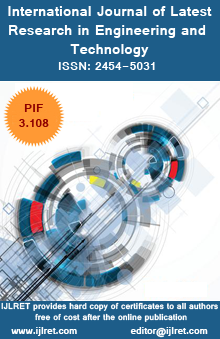Vol. 11, No. 01 [January 2025]
- Citation
- Abstract
- Reference
- PDF Download
| Paper Title | :: | Summary of the new ZJ Transform and its application to Differential Equations, Partial Equations and Integral Equations |
| Author Name | :: | M. Sc. Zenteno Jiménez José Roberto |
| Country | :: | México |
| Page Number | :: | 01-10 |
The following article is a summary and application with results on the ZJ Transform to solve Differential, Partial, Integro Differential and Integral Equations, we use the Integral Transform to solve by a simpler algebraic way the reduction to simpler differential equations, the integral transform as such "maps" an equation in its original domain to another suitable domain (for example, the Fourier Transform, Laplace, Mellin, etc ...). subsequently the solution is then re- mapped to the original domain with the inverse transform of said transform. The ZJ integral transform is based on that concept of changing the original domain to a suitable one in order to reduce the expression.
Keywords: Laplace Transform, ZJ Transform, Integral Transform, Partial Differential Equations, Ordinary Differential Equations, Integral Equations
Keywords: Laplace Transform, ZJ Transform, Integral Transform, Partial Differential Equations, Ordinary Differential Equations, Integral Equations
[1]. ElzakiTarig The New Integral Transform ''Elzaki Transform'' Tarig. M. Elzaki Global Journal of Pure and Applied Mathematics ISSN 0973-1768 Volume 7, Number 1 (2011), pp. 57–64 © Research India Publications.
[2]. Eman A. Mansour et al 2021 J. Phys.: Conf. Ser. 1999 012155 Application of New Transform “Complex SEE Transform” to Partial Differential Equations Fethi Bin Muhammed Belgacem and Ahmed Abdullatif Karaballi. Sumudu transform fundamental properties investigations and applications, Publishing Corporation Journal of Applied Mathematics and Stochastic Analysis Volume 2006, Article ID 91083, Pages 1–23 DOI 10.1155/JAMSA/2006/91083
[3]. H. Eltayeb, A. Kiliman, B. Fisher A new integral transform and associated distributions Integral Transforms Special Funct, 21 (5) (2010), pp. 367-379
[4]. Hassan Eltayeb and AdemKılı¸cman. A Note on the Sumudu Transforms and Differential Equationsn
[5]. Hossein Jafari, A new general integral transform for solving integral equations, Journal of Advanced Research, Volume 32, 2021, Pages 133-138, ISSN 2090-1232, https://doi.org/10.1016/j.jare.2020.08.016. (https://www.sciencedirect.com/science/article/pii/S2090123220302022 )
[2]. Eman A. Mansour et al 2021 J. Phys.: Conf. Ser. 1999 012155 Application of New Transform “Complex SEE Transform” to Partial Differential Equations Fethi Bin Muhammed Belgacem and Ahmed Abdullatif Karaballi. Sumudu transform fundamental properties investigations and applications, Publishing Corporation Journal of Applied Mathematics and Stochastic Analysis Volume 2006, Article ID 91083, Pages 1–23 DOI 10.1155/JAMSA/2006/91083
[3]. H. Eltayeb, A. Kiliman, B. Fisher A new integral transform and associated distributions Integral Transforms Special Funct, 21 (5) (2010), pp. 367-379
[4]. Hassan Eltayeb and AdemKılı¸cman. A Note on the Sumudu Transforms and Differential Equationsn
[5]. Hossein Jafari, A new general integral transform for solving integral equations, Journal of Advanced Research, Volume 32, 2021, Pages 133-138, ISSN 2090-1232, https://doi.org/10.1016/j.jare.2020.08.016. (https://www.sciencedirect.com/science/article/pii/S2090123220302022 )
- Citation
- Abstract
- Reference
- PDF Download
| Paper Title | :: | An Adaptive Algorithm for Roots of Non-Linear Equations |
| Author Name | :: | Chaman Lal Sabharwal |
| Country | :: | USA |
| Page Number | :: | 11-15 |
Optimization problems lead to non-linear equations fordetermining their roots efficiently. Finding the roots of a non-linear equation is a fundamental problem in diverse fields. Numerical iterative techniques become necessary when analytic solution is not available. Recently, some attempts Adapt1 combination of Bisection and Regula Falsi; Adapt2 a blend of Trisection and Regula Falsi; and Adapt3 a composite of Trisection and New-ton-Raphson methods emerged to design adaptive algorithms. In this paper, we design a new heuristic algorithm Adapt4 which is an intuitive approach. The new algorithmAdapt4 promises to be more efficient than the existing adaptive algorithms. The new adapted algorithm is a blend of BT section algorithm and Regula Falsi algorithm. The algorithm Adapt4 reduces the number of iterations and the computation time of each iteration. The imple-mentation results validate that the new algorithmAdapt4, surpasses theefficiency of existing such algorithms Adapt1, Adapt2, and Adapt3 algorithms. This paper contributes an essential adaptive algorithm for finding roots of frequent engineering equations.
Keywords: Regula False; Newton-Raphson; Bisection; Trisection; BTsection; Adaptive Algorithm
Keywords: Regula False; Newton-Raphson; Bisection; Trisection; BTsection; Adaptive Algorithm
[1]. Steven C Chapra and Raymond P Canale, Numerical Methods for Engineers, 7th Edition, McGraw-Hill Publishers, 2015.
[2]. John H. Mathews and Kurtis K. Fink Numerical Methods Using Matlab, 4th Edition, 2004 ISBN: 0-13-065248-2 Prentice-Hall Inc. Upper Saddle River, New Jersey, USA
[3]. J. F. Traub: Iterative Methods for the Solution of Equations, Chelsea Publishing company, New York, NY, USA, 1982.
[4]. Douglas Wilhelm Harder, https://ece.uwaterloo.ca/~dwharder/NumericalAnalysis/10RootFinding/falseposition/, accessed Jun 2019.
[5]. Ehiwario, J.C., Aghamie, S.O.; Comparative Study of Bisection, Newton-Raphson and Secant Methods of Root- Finding Problems; IOSR Journal of Engineering (IOSRJEN) www.iosrjen.org; ISSN (e): 2250-3021, ISSN (p): 2278-8719; Vol. 04, Issue 04 (April. 2014), ||V1|| PP 01-07.
[2]. John H. Mathews and Kurtis K. Fink Numerical Methods Using Matlab, 4th Edition, 2004 ISBN: 0-13-065248-2 Prentice-Hall Inc. Upper Saddle River, New Jersey, USA
[3]. J. F. Traub: Iterative Methods for the Solution of Equations, Chelsea Publishing company, New York, NY, USA, 1982.
[4]. Douglas Wilhelm Harder, https://ece.uwaterloo.ca/~dwharder/NumericalAnalysis/10RootFinding/falseposition/, accessed Jun 2019.
[5]. Ehiwario, J.C., Aghamie, S.O.; Comparative Study of Bisection, Newton-Raphson and Secant Methods of Root- Finding Problems; IOSR Journal of Engineering (IOSRJEN) www.iosrjen.org; ISSN (e): 2250-3021, ISSN (p): 2278-8719; Vol. 04, Issue 04 (April. 2014), ||V1|| PP 01-07.
- Citation
- Abstract
- Reference
- PDF Download
| Paper Title | :: | Ensuring Security in Cyberspace |
| Author Name | :: | Denys Malakhov |
| Country | :: | USA |
| Page Number | :: | 16-19 |
The article analyzes the specifics of ensuring security in cyberspace. The concept and essence of cyber threats and cyber attacks, statistics of the consequences of successful cyber attacks in Russia are considered. The main types of cyber threats and the goals of cybercriminals are given. The areas of ensuring the cybersecurity of the organization are identified, the possibility of using artificial intelligence and machine learning technologies is noted. The importance of a proactive position in cybersecurity issues is emphasized.
Keywords: cyberspace, cyber threats, cyber attacks, cybersecurity, cyber resilience.
Keywords: cyberspace, cyber threats, cyber attacks, cybersecurity, cyber resilience.
[1]. Gavrilova U.V., Subocheva O.N., Krasulina K.R., Social security in cyberspace: specifics and technologies of violation. // Social'no-gumanitarnye znaniya. – 2023 - #12 p.195-199
[2]. Ivanova E.S., Evdokimova A.N. Cybersecurity is at the heart of ensuring country’s national security. // Zhurnal prikladnykh issledovanij – 2022 – v.7, #11 p.559-563. DOI: 10.47576/2712-7516_2022_11_7_559
[3]. Cremer F., Sheehan B., Fortmann M., Kia A.N., Mullins M., Murphy F., Materne S. Cyber risk and cybersecurity: a systematic review of data availability. Geneva Pap Risk Insur Issues Pract, 2022, vol. 47, no. 3, pp. 698-736. DOI: 10.1057/s41288-022-00266-6
[4]. Yuchong L., Qinghui L. A comprehensive review study of cyber-attacks and cyber security; Emerging trends and recent developments. Energy Reports, 2021, vol. 7, pp. 8176-8186. DOI: 10.1016/j.egyr.2021.08.126
[5]. A Closer Look at Q3 2024: 75% Surge in Cyber Attacks Worldwide // Check Point. – 2024. – URL: https://blog.checkpoint.com/research/a-closer-look-at-q3-2024-75-surge-in-cyber-attacks-worldwide/ (date of request: 10.01.2025).
[2]. Ivanova E.S., Evdokimova A.N. Cybersecurity is at the heart of ensuring country’s national security. // Zhurnal prikladnykh issledovanij – 2022 – v.7, #11 p.559-563. DOI: 10.47576/2712-7516_2022_11_7_559
[3]. Cremer F., Sheehan B., Fortmann M., Kia A.N., Mullins M., Murphy F., Materne S. Cyber risk and cybersecurity: a systematic review of data availability. Geneva Pap Risk Insur Issues Pract, 2022, vol. 47, no. 3, pp. 698-736. DOI: 10.1057/s41288-022-00266-6
[4]. Yuchong L., Qinghui L. A comprehensive review study of cyber-attacks and cyber security; Emerging trends and recent developments. Energy Reports, 2021, vol. 7, pp. 8176-8186. DOI: 10.1016/j.egyr.2021.08.126
[5]. A Closer Look at Q3 2024: 75% Surge in Cyber Attacks Worldwide // Check Point. – 2024. – URL: https://blog.checkpoint.com/research/a-closer-look-at-q3-2024-75-surge-in-cyber-attacks-worldwide/ (date of request: 10.01.2025).
- Citation
- Abstract
- Reference
- PDF Download
| Paper Title | :: | Man-Woman Relationship: George, Lettie, Leslie |
| Author Name | :: | Surabhi Kumari |
| Country | :: | India |
| Page Number | :: | 20-22 |
In The White Peacock, D.H. Lawrence explores the complex dynamics of human relationships, particularly focusing on the intertwined lives of George, Lettie, and Leslie. The central theme revolves around the emotional and psychological struggles in their love triangle. George is a sensitive, introspective man, deeply connected to nature, and represents the idealistic yet troubled figure in the narrative. Lettie, caught between her desires for both George and Leslie, embodies the struggle of emotional conflict, torn between different aspects of love and personal fulfillment. Leslie, a more practical and grounded character, contrasts sharply with George‟s dreaminess. His affections for Lettie form a key aspect of the triangle. The novel delves into the tension between idealistic love and the stark reality of human imperfection. George and Lettie's romantic connection is strained by his deep attachment to nature, while Lettie is drawn to Leslie‟s more pragmatic approach to life. The emotional complexities in their interactions reveal the contrasts between idealism and realism in relationships, exploring themes of self-discovery, unrequited love, and the difficulties of balancing personal aspirations with love. The characters' relationships reflect broader themes of identity and emotional fulfillment, offering a poignant commentary on the conflicts inherent in the human condition.
Keywords: Embodies, Emotional Conflict, Sensitive, Nature and Represents etc
Keywords: Embodies, Emotional Conflict, Sensitive, Nature and Represents etc
[1]. Graham Hough,: The Dark Sun, p. 38
[2]. D.H. Lawrence,: The White Peacock, p.13
[3]. D. H. Lawrence: The White Peacock, p. 36
[4]. Ben Jonson : a quote from Ben Jonson‟s poem‟ by Lettie The White Peacock, p. 30
[5]. D.H. Lawrence: The White Peacock, p. 30
[2]. D.H. Lawrence,: The White Peacock, p.13
[3]. D. H. Lawrence: The White Peacock, p. 36
[4]. Ben Jonson : a quote from Ben Jonson‟s poem‟ by Lettie The White Peacock, p. 30
[5]. D.H. Lawrence: The White Peacock, p. 30


